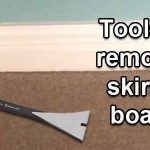When skirting boards are first fitted, joints along the top of the board, as well as mitres and scribes are all caulked prior to painting. Also, holes where fixings are used, are filled with filler, and sanded to completely hide them. The end result is a neat seamless finish, where no obvious gaps or imperfections can be seen.
However, this may not last for ever. It is very common for cracks, gaps, and minor imperfections to appear over time.

Most cracks in skirting boards will appear at corner joints, such as scribes and mitres. As well as along the top of the board, where your skirting meets the wall. Any of these cracks can make even a perfectly finished skirting board look a little rough.
The good news is, fixing cracks in skirting boards is relatively simple. You simply need to remove any old filler and caulk, clean up the area, ensure it is still fitted securely, and then reapply and paint.
Cleaning and refilling skirting board cracks
In order to refill cracks neatly, you will need to remove all old sealant. On joints, this will generally be caulk, which can be scraped out with a Stanley knife. Your goal is to remove any loose, old caulk.
Once you have removed the caulk, you will need to sand the area in order to create a smooth surface. Following this, remove any dust with a soft brush.
It is important that you check the board is secure, prior to adding any new filler. If the board has come away from the wall at the top, this could be a sign of poor fixing when first installed.
A couple of well-placed screws should pull the skirting board back tight to the walls surface. For stud walls this is easy, simply locate a stud and screw straight into it. For a solid wall, you will need to drill and fix with a plug and screw.
Pre-drill and countersink the hole before adding your fixing. This will ensure it can be filled and hidden easily.
If your cracks are on the internal scribes, a solid fixing near the corner, can also reduce future movement.
It is important to realise, that movement is going to happen regardless. This happens as temperatures and humidity fluctuate in a property. These changes cause things like skirting, and architrave, to expand and contract slightly.
If your skirting is fixed solid, this will drastically reduce movement at joints and seams.
Once the area is fixed and completely clean of dust, you can reapply caulk to the joints and filler to any fixing holes. Caulk should be smoothed with your finger and filler should be sanded smooth once dry.
Once this is all done, the skirting can be repainted, and the problem shouldn’t return.
How to avoid cracks in skirting board
Fixing cracks in skirting boards is relatively simple. However, in an ideal world, you wouldn’t need to do it at all, and if you take the time to fix skirting properly, you might not have too.
When fixing your skirting boards, there are 4 main things you should be doing:
- Ensure the surface you are fixing to is clean and free from dust – Any adhesive you use on the back of the boards should be able to get a good solid grip on the surface.
- Make sure your cuts are tight – If your scribes and mitres already have gaps when you fit them, even a small contraction will open the gap further.
- Glue joints – It is unbelievable to me how many people don’t do this. It takes a couple of extra seconds and it’s easy to do. Simply put a bead of wood glue down the edge of your scribe or mitre and smooth with your finger. This will ensure the entire joint has an adhesive fixing. For mitres you could use something stronger like mitre mate for an even better fixing.
- Use a combination of grab adhesive and mechanical fixings – You should apply a strong adhesive to the back of your boards. Something like pink grip is perfect and pretty cheap. I like to apply this in a curvy line, rotating from top to bottom over the length of the Skirting. This ensures a solid fixing.
Following this, you should either fix with screws, or pin the skirting board with a second fix nail gun. Ensure you are adding two fixings at roughly 400mm intervals. One near the top of the board, and one near the bottom.
Also, try to get some fixings close to any corner joints such as scribes, as this will help to reduce movement at the joint.
If you follow these steps correctly, your skirting board should already have nice tight joints, and the fixings should be solid to reduce movement.
For some reason people like to cut corners with this type of job. I never understood this. All the steps above combined take minimal time, and they mean you won’t have to revisit the job in the future.
I can guarantee, if you follow these steps you will not be refilling gaps and cracks in your skirting boards.
Conclusion
Fixing cracks in skirting boards is pretty easy. You just need to ensure the area is clean and secure. Once this is the case, new filler and caulk can be added and redecorated, providing a nice clean finish.
If you are fitting new skirting boards, remember, prevention is better than the cure. Just do the job right once, and it is far less likely you will ever need to revisit it again.



